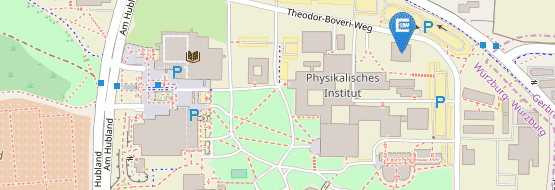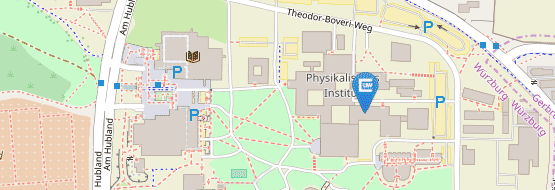Physical Review Research | PDF
We build Floquet-driven capacitive circuit networks to realize topological states of matter in the frequency domain. As visible through our Floquet Laplacian formalism, the intertwining of static circuit components and parametric Floquet driving effectively creates a barrier in the frequency dimension, allowing to resolve the bulk-boundary correspondence of Floquet topological matter. By implementing a Su-Schrieffer-Heeger Floquet lattice model and measuring the associated circuit Laplacian and characteristic resonances, we demonstrate Floquet topological edge modes emerging at this frequency space barrier. Floquet circuits allow for the creation of topological phenomena in synthetic frequency dimensions with just a single unit cell of time-variable circuit components.
Nature Communications Physics | PDF
The use of the THz frequency domain in future network generations offers an unparalleled level of capacity, which can enhance innovative applications in wireless communication, analytics, and imaging. Communication technologies rely on frequency mixing, enabling signals to be converted from one frequency to another and transmitted from a sender to a receiver. Technically, this process is implemented using nonlinear components such as diodes or transistors. However, the highest operating frequency of this approach is limited to sub-THz bands. Here, we demonstrate the upconversion of a weak sub-THz signal from a photoconductive antenna to multiple THz bands. The key element is a high-mobility HgTe-based heterostructure with electronic band inversion, leading to one of the strongest third-order nonlinearities among all materials in the THz range. Due to the Dirac character of electron dispersion, the highly intense sub-THz radiation is efficiently mixed with the antenna signal, resulting in a THz response at linear combinations of their frequencies. The field conversion efficiency above 2% is provided by a bare tensile-strained HgTe layer with a thickness below 100 nm at room temperature under ambient conditions. Devices based on Dirac materials allow for high degree of integration, with field-enhancing metamaterial structures, making them very promising for THz communication with unprecedented data transfer rate.
Physical Review Materials | PDF
We present a systematic experimental study of the topological phase transition in a series of ∼10nm thick Hg1−xCdxTe quantum wells by tuning the Cd content x. We provide detailed structural and magneto-optical spectroscopic characterization measurements and establish a comprehensive picture of the alloy structural and energetic properties. Using these as input, we employ k·p modeling to establish the topological phase diagram of Hg1−xCdxTe in dependence on the Cd content and quantum well thickness for thin films which are pseudomorphically strained to the lattice constant of pure CdTe.
SciPost Physics Codebases (Article) | PDF
SciPost Physics Codebases (Codebase release)
The software project kdotpy provides a Python application for simulating electronic band structures of semiconductor devices with k·p theory on a lattice. The application implements the widely used Kane model, capable of reliable predictions of transport and optical properties for a large variety of topological and non-topological materials with a zincblende crystal structure. The application automates the tedious steps of simulating band structures. The user inputs the relevant physical parameters on the command line, for example materials and dimensions of the device, magnetic field, and temperature. The program constructs the appropriate matrix Hamiltonian on a discretized lattice of spatial coordinates and diagonalizes it. The physical observables are extracted from the eigenvalues and eigenvectors and saved as output. The program is highly customizable with a large set of configuration options and material parameters.
Physical Review Research | PDF
Quantized adiabatic transport can occur when a system is slowly modulated over time. In most realizations, however, the efficiency of such transport is reduced by unwanted dissipation, back-scattering, and nonadiabatic effects. In this paper, we realize a topological adiabatic pump in an electrical circuit network that supports remarkably stable and long-lasting pumping of a voltage signal. We further characterize the topology of our system by deducing the Chern number from the measured edge band structure. To achieve this, the experimental setup makes use of active circuit elements that act as time-variable voltage-controlled inductors.
Physical Review Research | PDF
A striking feature of three-dimensional (3D) topological insulators (TIs) is the theoretically expected topological magnetoelectric (TME) effect, which gives rise to additional terms in Maxwell's laws of electromagnetism with an universal quantized coefficient proportional to half-integer multiples of the fine-structure constant α. In an ideal scenario one therefore expects also quantized contributions in the magnetooptical response of TIs. We review this premise by taking into account the trivial dielectric background of the TI bulk and potential host substrates, and the often present contribution of itinerant bulk carriers. We show (i) that one obtains a nonuniversal magnetooptical response whenever there is impedance mismatch between different layers and (ii) that the detectable signals due to the TME rapidly approach vanishingly small values as the impedance mismatch is detuned from zero. We demonstrate that it is methodologically impossible to deduce the existence of a TME exclusively from an optical experiment in the thin film limit of 3D TIs at high magnetic fields.
Journal of Applied Physics | PDF
We present a setup for fast, low-bias ( ≤ 1 mV) DC transport measurements with μs time resolution for high ohmic resistance ( ≈ 20 k Ω) semiconducting samples. We discuss the circuitry and instrumentation for the measurement approach that can be applied to any kind of semiconductor device or (gated) two-dimensional material and demonstrate the main measurement artifacts in typical measurements by means of circuit simulation. Based on the latter, we present a simple two-step protocol for eliminating the measurement artifacts reliably. We demonstrate the technique by measuring the transitions between quantum Hall plateaus in the HgTe quantum wells and resolve plateaus as short-lived as 100 μs.






